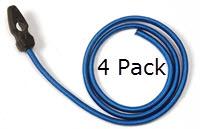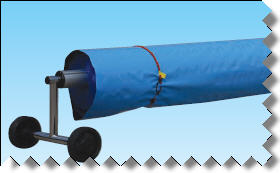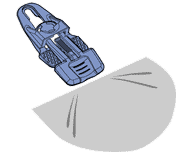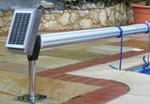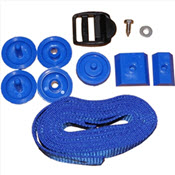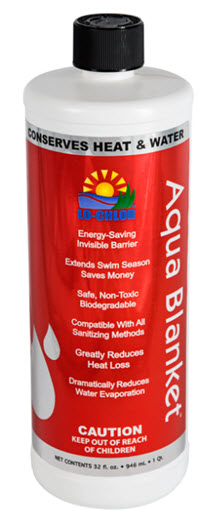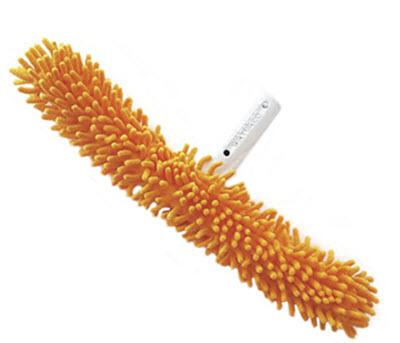Trouble Shooting 4 Pools

trouble
Can't detect any chlorine
A frequent problem that we have customers ring up for is that they can't detect any chlorine despite adding it to the pool. They add chlorine, test, find none, add more, test.....What is going on? Well, like so many other pool problems, there can be a number of possible causes.
The three most common causes are:
Using a DPD chlorine test when the chlorine is more than 15 ppm.
DPD (the chlorine test indicator that turns pink) is bleached by chlorine levels in excess of 15 ppm.
You can check if this is happening if you are using a dip cell test (with DPD 1 tablets by adding the tablet to the cell while it is empty then slowly adding the water to the cell and watching what happens. If the chlorine is over 15 ppm you will observe the water go pink when a little water is added and then turn clear or a pale straw colour as more is added.
To get an accurate reading dilute one part of the pool sample with four parts tap water and carry out the test as normal. The true reading is your test result multiplied by five.
Having a lot of algae in the pool.
When a pool has been left and goes off (usually green) the normal method of making the pool water clear and blue again is to add large amounts of chlorine. This is known as shocking the pool). In the process of killing the algae the chlorine is used up. It appears that you are adding chlorine and it is just disappearing. (see : My pool has gone green)
Having sunny weather and no stabilizer.
Chlorine is broken down by sunlight. This can happen quite quickly even in a British summer making it very difficult to keep free chlorine in the water. The answer is to add a stabiliser or use a sanitiser with a stabiliser included.
My pool has gone green
Swimming pool water has a green appearance for a few possible reasons :
The most common is algae in the water and on the sides of the pool however it can also be caused by the filter not working properly or air dissolved in the water.
The method of getting the water back to being blue and clear varies according to how green it is and what the cause is.
Green due to algae
Algae will not start in water that has even a small amount of chlorine or bromine present (1 part per million). This is why algae often starts in the corners of the pool where there is very little water movement so the chlorine in the water is used up and not replenished by new chlorinated water. Therefore when we have got rid of any algae the best way to prevent its' re-occurrence is to test regularly, run the circulation frequently, maintain a good level of chlorine or bromine and add an algaecide regularly.
Getting rid of algae
The best way of getting rid of algae suspended in the water is to boost the chlorine level of the water by adding a shock dose of chlorine to the water. The chemical most commonly used for this is in ground pools is calcium hypochlorite granules (shock granules). In above ground pools which are emptied every year or two stabilised chlorine granules can be used. NEVER MIX CALCIUM HYPOCHLORITE AND STABILISED CHLORINE GRANULES AS THEY CAN EXPLODE!!
The amount of shock granules you will require depends on how much algae is in the water.
In the process of killing the algae the chlorine is used up. It appears that you are adding chlorine and it is just disappearing. The dead algae break down in the water and have the potential to be food for any still alive. Therefore to get rid of the algae completely sufficient chlorine has to be added to kill the complete population in the pool and establish a level of chlorine in the water; otherwise the algae carries on breeding in the pool so the chlorine seems to be having no effect. For this reason on pools which are very green the pool may have to be shocked several times.
The normal shock dose is 500 grams per 10,000 gallons of pool water.
As a rough guide
500 grams in 10,000 gallons is sufficient to clear a pool which is slightly green (objects on the bottom of a 2 metre deep pool are visible).
If you can only just see the bottom in 1 metre of water add 1000 grams per 10,000 gallons.
If you can't see the bottom, add 1500 grams per 10,000 gallons.
If the water looks like pea soup add 2000 grams per 10,000 gallons.
In each case put about 8 litres of luke warm water in a plastic bucket and dissolve 500 grams of calcium hypochlorite (shock granules ).Mix well. Calcium hypochlorite does not dissolve completely so you will get a milky suspension. REMEMBER always add chemical to water NOT water to chemical.
Ideally this solution should be added slowly into a skimmer, with the circulation pump running, so that it will get well mixed throughout the pool water.
(BEWARE DO NOT PUT CALCIUM HYPOCHLORITE INTO A SKIMMER THAT HAS EVEN A TRACE OF ANY STABILISED CHLORINE IN IT AS THEY REACT EXPLOSIVELY.)
Repeat this process until you have added the required amount of chlorine or the algae turns to a greyish colour.
If you cannot add to a skimmer try spreading the solution through the pool as evenly as possible using a plastic watering can.
Allow the pool to circulate for at least 2 hours. Check the chlorine level. It should be above 5 ppm but may be very high ( SEE Can't detect any chlorine). If the chlorine level is low and the algae is still green add another shock dose (500 gram per 10,000 gallons).
If your pool was very green it will now be cloudy due to dead algae. The dead algae has to be filtered out so it is best to add 250 mls. of Sparkle Water Clarifier per 10,000 gallons and run the filter continuously. Some of the dead algae will drop to the bottom of the pool which will need to be vacuumed out.
Algae growing on the sides and bottom of the pool.
Just shocking the pool is unlikely to get rid of algae growing on the pool sides and bottom. This algae will need to be physically removed by scrubbing and then shocking the pool as described above. If your pool is a tiled or concrete pool and the algae is growing in the grout you can sprinkle some shock granules into the pool allowing them to sink to the bottom and then brush the granules over the algae. In severe cases you may need to scrub with an algae brush.
Do not allow shock chlorine to stay on the bottom of a liner pool as prolonged contact may discolour the liner.
When you have cleared the algae add 1 litre of Polyquat algaecide per 10,000 gallons Or switch to multifunctional tablets which contain an algaecide and flocculant.
Cloudy water
My pool is cloudy, but not green.
Check the chlorine level, pH, alkalinity and cyanuric acid (stabiliser ) level.
Adjust the pH to between 7.2 and 7.6.
Add chlorine to bring the level to between 1 and 3 ppm.
If the cyanuric acid level is very high reduce by replacing a proportion of the water.
If the alkalinity is very low increase by adding alkalinity builder (5 kg increases alkalinity by 66 ppm in a 10,000 gallon pool).
If all the chemical parameters are correct check that the pump and filter are working.
i.e put your hand over an inlet and check the water is returning to the pool.
Add 250 mls of Sparkle per 10,000 gallons and keep the filter running overnight.
If the pool has not cleared check that the filter is working properly.
First back wash the filter. Then remove the lid. Check the level of the sand (it should be at least two thirds full) using a tape measure as when the filter is full of water it looks as though the sand is closer to the top than it is. Also observe the state of the sand. It should have reasonably level surface, the sand should look clean with no gaps around the sides or holes in it. (NOTE an indication that there is something is wrong with the filter is that there is sand in the bottom of the pool. This is caused by damage to the distributor at the bottom of the filter.)
If the sand level is not as described above, the filter should be emptied and the distributor at the bottom checked, repaired and new sand put in the filter.
The other common cause of cloudy water is tiny bubbles of air in the water. If this is the cause the pool will tend to go cloudier when the water is disturbed by bathers. The water may clear when the circulation is turned off for a few hours, and small bubbles may be observed on the sides of the pool.
The air will be getting sucked in from a leak in the suction side of the pump. The most common cause is a poorly fitting strainer lid, a failed seal on the pump or a crack in the suction pipes.
Stains
One problem that metal oxides can cause is staining on the pools surfaces. If the stain is detected early on then brushing can normally remove it. If it is ignored then the pool may require draining then cleaned via an acid wash. Stains can appear in various colours depending on the metal apparent in the water.
Stain Colour Cause Treatment
Blue/Green Copper or iron corrosion or from the water supply. Adjust pH & alkalinity to recommended ranges.
Brush the stained areas thoroughly.
Add sequestering agent and run filter.
Two days later, shock-treat the water.
Retest the pH & alkalinity. Also test hardness levels and raise the hardness to 200 ppm if necessary.
Red/Brown Iron or manganese corrosion or from water supply.
Black Manganese in the water supply.
Scale Formations
Scale formations appear in the form of crusty white deposits on the pool surface. The consequence of this is a rough surface on the pool and a reduction in the circulation of pool water as scale builds up inside the filter and plumbing system. Scale usually appears due to a defect in the pH, calcium hardness or total alkalinity levels. More often than not, one of these levels will be too high but it has been known for all three to be high. If the latter applies then firstly reduce the pH and the alkalinity levels as reducing the calcium hardness level is much more difficult. If the calcium hardness level is causing the problem then it is best to drain part of the pool water and replace it with fresh water, which has a low level of hardness and TDS.
Problem Causes Treatment
Crusty deposit on pool surfaces High calcium hardness
High pH & alkalinity
Adjust pH and alkalinity to ideal ranges. (7.2-7.6 & 120-160 ppm respectively)
Replace a portion of water with fresh water, which is low in hardness and TDS.
Use a sequestering agent to prevent scale build-up if high hardness levels are a reoccurring problem.
Corrosion
Corrosion can cause severe damage to pools or spas if the problem is not addressed early on. Low levels of pH, alkalinity and hardness usually cause corrosion however low temperatures and high TDS levels can also contribute. The most severe problems that corrosion can cause are not always noticeable on the surface of the pool or spa. For example equipment such as the heater, pumps and pipes can be damaged by corrosion and in some circumstances can fail. This means replacements are required resulting in unnecessary expenses.
pH Problems
Low pH Level - Low pH levels can occur either due to a low level of pH in the water supply or the use of acidic chlorine donors. Both of these lead to an insufficient level of alkali in the water, which can only be increased by using pH increaser(sodium carbonate) to raise the level to 7.2 - 7.6. In soft water areas it may be necessary to increase the alkalinity level to at least 80 ppm. For more information see erratic pH levels below.
High pH Level - A high pH level in the water supply and the indication of salts in the water can contribute to high pH levels in pool water. In both circumstances pH reducer (dry acid) can be used to reduce the level to 7.2 - 7.6. A high alkalinity level in the pool can also lead to a high pH level. To rectify this allow the alkalinity level to come down to 80ppm, test the pH and adjust to 7.2 - 7.6 using pH increaser or pH reducer.
Erratic pH Levels - By maintaining an alkalinity level of approximately 80-140ppm this stabilises the pH level and prevents any fluctuations in the pH level. However if there isn’t a sufficient amount of bicarbonate in the water then the low alkalinity level leads to changes in the pH level. The addition of Alkalinity builder (Sodium Bicarbonate) will increase the alkalinity level and stabilise the pH.
pH Locked - At the other end of the scale a high alkalinity level can lead to pH lock. This can be resolved by letting the alkalinity level return to 80ppm
Eye and Skin Irritations
The main cause of eye and skin irritation in pools is high chloramines. Bathers usually experience eye and skin irritation when the chloramines level exceeds 0.5ppm. Performing a backwash or replacing some of the water can reduce this level. Another factor that can cause irritation is a very low pH level (below 6.8) or a very high pH level (above 8.2 when using Bromine). However if the pH is kept in its ideal range (7.2-7.6) this should not cause a problem.
Foaming
Foaming is caused by a reaction that takes place between the natural alkalinity of the water and the bathers body oils. If the bather hasn't showered before getting in the water then any cosmetic products, suntan lotions or detergents will wash off into the water. Obviously this can be helped by showering before getting into the water however Antifoam might be required to get rid of any excess detergents.
Another cause of foaming is soft water. If you have a low calcium hardness level then this needs to be increased to at least 200 ppm to prevent foaming.
Filtration
If your water is balanced but your water is still cloudy the problem could be situated in your filter. The filter plays an important role in sustaining clear water however as it accumulates all the debris, pressure builds and the filter becomes less effective. To release this pressure the filter needs to be cleaned. For sand filters this involves a backwash, whilst for cartridge filters the dirty filter is replaced by a clean one, with the dirty filter being cleaned ready for the next replacement.
Chemical Storage
+ Minimize the different types of chemicals you store.
+ Don't buy more than you will consume in a season. Some of the more hazardous pool chemicals don't keep well.
+ Keep wet hands and dirty scoops out of your chemicals. Contamination is often a cause of problems.
+ Don't store pool chemicals where other materials can fall into them.
+ Never, NEVER, NEVER, mix chemicals. When adding chemicals to your pool allow one to disappear before adding another.
+ Use gloves and glasses.
+ Make sure chemicals are locked away from small children.
+ Always label containers
+ ALL forms of acids react DANGEROUSLY with all forms of chlorine or bromine. Never, never, NEVER mix swimming pool chemicals of any type! Chlorine compounds that look or smell alike may not be the same: you have to know the actual chemical. Allowing even small amounts of different chlorine sanitizers to touch each other can be REALLY dangerous. In particular, trichlor and calcium hypochlorite can react dangerously on contact with each other. once they're dissolved in the pool, though, they get along fine.
A frequent problem that we have customers ring up for is that they can't detect any chlorine despite adding it to the pool. They add chlorine, test, find none, add more, test.....What is going on? Well, like so many other pool problems, there can be a number of possible causes.
The three most common causes are:
Using a DPD chlorine test when the chlorine is more than 15 ppm.
DPD (the chlorine test indicator that turns pink) is bleached by chlorine levels in excess of 15 ppm.
You can check if this is happening if you are using a dip cell test (with DPD 1 tablets by adding the tablet to the cell while it is empty then slowly adding the water to the cell and watching what happens. If the chlorine is over 15 ppm you will observe the water go pink when a little water is added and then turn clear or a pale straw colour as more is added.
To get an accurate reading dilute one part of the pool sample with four parts tap water and carry out the test as normal. The true reading is your test result multiplied by five.
Having a lot of algae in the pool.
When a pool has been left and goes off (usually green) the normal method of making the pool water clear and blue again is to add large amounts of chlorine. This is known as shocking the pool). In the process of killing the algae the chlorine is used up. It appears that you are adding chlorine and it is just disappearing. (see : My pool has gone green)
Having sunny weather and no stabilizer.
Chlorine is broken down by sunlight. This can happen quite quickly even in a British summer making it very difficult to keep free chlorine in the water. The answer is to add a stabiliser or use a sanitiser with a stabiliser included.
My pool has gone green
Swimming pool water has a green appearance for a few possible reasons :
The most common is algae in the water and on the sides of the pool however it can also be caused by the filter not working properly or air dissolved in the water.
The method of getting the water back to being blue and clear varies according to how green it is and what the cause is.
Green due to algae
Algae will not start in water that has even a small amount of chlorine or bromine present (1 part per million). This is why algae often starts in the corners of the pool where there is very little water movement so the chlorine in the water is used up and not replenished by new chlorinated water. Therefore when we have got rid of any algae the best way to prevent its' re-occurrence is to test regularly, run the circulation frequently, maintain a good level of chlorine or bromine and add an algaecide regularly.
Getting rid of algae
The best way of getting rid of algae suspended in the water is to boost the chlorine level of the water by adding a shock dose of chlorine to the water. The chemical most commonly used for this is in ground pools is calcium hypochlorite granules (shock granules). In above ground pools which are emptied every year or two stabilised chlorine granules can be used. NEVER MIX CALCIUM HYPOCHLORITE AND STABILISED CHLORINE GRANULES AS THEY CAN EXPLODE!!
The amount of shock granules you will require depends on how much algae is in the water.
In the process of killing the algae the chlorine is used up. It appears that you are adding chlorine and it is just disappearing. The dead algae break down in the water and have the potential to be food for any still alive. Therefore to get rid of the algae completely sufficient chlorine has to be added to kill the complete population in the pool and establish a level of chlorine in the water; otherwise the algae carries on breeding in the pool so the chlorine seems to be having no effect. For this reason on pools which are very green the pool may have to be shocked several times.
The normal shock dose is 500 grams per 10,000 gallons of pool water.
As a rough guide
500 grams in 10,000 gallons is sufficient to clear a pool which is slightly green (objects on the bottom of a 2 metre deep pool are visible).
If you can only just see the bottom in 1 metre of water add 1000 grams per 10,000 gallons.
If you can't see the bottom, add 1500 grams per 10,000 gallons.
If the water looks like pea soup add 2000 grams per 10,000 gallons.
In each case put about 8 litres of luke warm water in a plastic bucket and dissolve 500 grams of calcium hypochlorite (shock granules ).Mix well. Calcium hypochlorite does not dissolve completely so you will get a milky suspension. REMEMBER always add chemical to water NOT water to chemical.
Ideally this solution should be added slowly into a skimmer, with the circulation pump running, so that it will get well mixed throughout the pool water.
(BEWARE DO NOT PUT CALCIUM HYPOCHLORITE INTO A SKIMMER THAT HAS EVEN A TRACE OF ANY STABILISED CHLORINE IN IT AS THEY REACT EXPLOSIVELY.)
Repeat this process until you have added the required amount of chlorine or the algae turns to a greyish colour.
If you cannot add to a skimmer try spreading the solution through the pool as evenly as possible using a plastic watering can.
Allow the pool to circulate for at least 2 hours. Check the chlorine level. It should be above 5 ppm but may be very high ( SEE Can't detect any chlorine). If the chlorine level is low and the algae is still green add another shock dose (500 gram per 10,000 gallons).
If your pool was very green it will now be cloudy due to dead algae. The dead algae has to be filtered out so it is best to add 250 mls. of Sparkle Water Clarifier per 10,000 gallons and run the filter continuously. Some of the dead algae will drop to the bottom of the pool which will need to be vacuumed out.
Algae growing on the sides and bottom of the pool.
Just shocking the pool is unlikely to get rid of algae growing on the pool sides and bottom. This algae will need to be physically removed by scrubbing and then shocking the pool as described above. If your pool is a tiled or concrete pool and the algae is growing in the grout you can sprinkle some shock granules into the pool allowing them to sink to the bottom and then brush the granules over the algae. In severe cases you may need to scrub with an algae brush.
Do not allow shock chlorine to stay on the bottom of a liner pool as prolonged contact may discolour the liner.
When you have cleared the algae add 1 litre of Polyquat algaecide per 10,000 gallons Or switch to multifunctional tablets which contain an algaecide and flocculant.
Cloudy water
My pool is cloudy, but not green.
Check the chlorine level, pH, alkalinity and cyanuric acid (stabiliser ) level.
Adjust the pH to between 7.2 and 7.6.
Add chlorine to bring the level to between 1 and 3 ppm.
If the cyanuric acid level is very high reduce by replacing a proportion of the water.
If the alkalinity is very low increase by adding alkalinity builder (5 kg increases alkalinity by 66 ppm in a 10,000 gallon pool).
If all the chemical parameters are correct check that the pump and filter are working.
i.e put your hand over an inlet and check the water is returning to the pool.
Add 250 mls of Sparkle per 10,000 gallons and keep the filter running overnight.
If the pool has not cleared check that the filter is working properly.
First back wash the filter. Then remove the lid. Check the level of the sand (it should be at least two thirds full) using a tape measure as when the filter is full of water it looks as though the sand is closer to the top than it is. Also observe the state of the sand. It should have reasonably level surface, the sand should look clean with no gaps around the sides or holes in it. (NOTE an indication that there is something is wrong with the filter is that there is sand in the bottom of the pool. This is caused by damage to the distributor at the bottom of the filter.)
If the sand level is not as described above, the filter should be emptied and the distributor at the bottom checked, repaired and new sand put in the filter.
The other common cause of cloudy water is tiny bubbles of air in the water. If this is the cause the pool will tend to go cloudier when the water is disturbed by bathers. The water may clear when the circulation is turned off for a few hours, and small bubbles may be observed on the sides of the pool.
The air will be getting sucked in from a leak in the suction side of the pump. The most common cause is a poorly fitting strainer lid, a failed seal on the pump or a crack in the suction pipes.
Stains
One problem that metal oxides can cause is staining on the pools surfaces. If the stain is detected early on then brushing can normally remove it. If it is ignored then the pool may require draining then cleaned via an acid wash. Stains can appear in various colours depending on the metal apparent in the water.
Stain Colour Cause Treatment
Blue/Green Copper or iron corrosion or from the water supply. Adjust pH & alkalinity to recommended ranges.
Brush the stained areas thoroughly.
Add sequestering agent and run filter.
Two days later, shock-treat the water.
Retest the pH & alkalinity. Also test hardness levels and raise the hardness to 200 ppm if necessary.
Red/Brown Iron or manganese corrosion or from water supply.
Black Manganese in the water supply.
Scale Formations
Scale formations appear in the form of crusty white deposits on the pool surface. The consequence of this is a rough surface on the pool and a reduction in the circulation of pool water as scale builds up inside the filter and plumbing system. Scale usually appears due to a defect in the pH, calcium hardness or total alkalinity levels. More often than not, one of these levels will be too high but it has been known for all three to be high. If the latter applies then firstly reduce the pH and the alkalinity levels as reducing the calcium hardness level is much more difficult. If the calcium hardness level is causing the problem then it is best to drain part of the pool water and replace it with fresh water, which has a low level of hardness and TDS.
Problem Causes Treatment
Crusty deposit on pool surfaces High calcium hardness
High pH & alkalinity
Adjust pH and alkalinity to ideal ranges. (7.2-7.6 & 120-160 ppm respectively)
Replace a portion of water with fresh water, which is low in hardness and TDS.
Use a sequestering agent to prevent scale build-up if high hardness levels are a reoccurring problem.
Corrosion
Corrosion can cause severe damage to pools or spas if the problem is not addressed early on. Low levels of pH, alkalinity and hardness usually cause corrosion however low temperatures and high TDS levels can also contribute. The most severe problems that corrosion can cause are not always noticeable on the surface of the pool or spa. For example equipment such as the heater, pumps and pipes can be damaged by corrosion and in some circumstances can fail. This means replacements are required resulting in unnecessary expenses.
pH Problems
Low pH Level - Low pH levels can occur either due to a low level of pH in the water supply or the use of acidic chlorine donors. Both of these lead to an insufficient level of alkali in the water, which can only be increased by using pH increaser(sodium carbonate) to raise the level to 7.2 - 7.6. In soft water areas it may be necessary to increase the alkalinity level to at least 80 ppm. For more information see erratic pH levels below.
High pH Level - A high pH level in the water supply and the indication of salts in the water can contribute to high pH levels in pool water. In both circumstances pH reducer (dry acid) can be used to reduce the level to 7.2 - 7.6. A high alkalinity level in the pool can also lead to a high pH level. To rectify this allow the alkalinity level to come down to 80ppm, test the pH and adjust to 7.2 - 7.6 using pH increaser or pH reducer.
Erratic pH Levels - By maintaining an alkalinity level of approximately 80-140ppm this stabilises the pH level and prevents any fluctuations in the pH level. However if there isn’t a sufficient amount of bicarbonate in the water then the low alkalinity level leads to changes in the pH level. The addition of Alkalinity builder (Sodium Bicarbonate) will increase the alkalinity level and stabilise the pH.
pH Locked - At the other end of the scale a high alkalinity level can lead to pH lock. This can be resolved by letting the alkalinity level return to 80ppm
Eye and Skin Irritations
The main cause of eye and skin irritation in pools is high chloramines. Bathers usually experience eye and skin irritation when the chloramines level exceeds 0.5ppm. Performing a backwash or replacing some of the water can reduce this level. Another factor that can cause irritation is a very low pH level (below 6.8) or a very high pH level (above 8.2 when using Bromine). However if the pH is kept in its ideal range (7.2-7.6) this should not cause a problem.
Foaming
Foaming is caused by a reaction that takes place between the natural alkalinity of the water and the bathers body oils. If the bather hasn't showered before getting in the water then any cosmetic products, suntan lotions or detergents will wash off into the water. Obviously this can be helped by showering before getting into the water however Antifoam might be required to get rid of any excess detergents.
Another cause of foaming is soft water. If you have a low calcium hardness level then this needs to be increased to at least 200 ppm to prevent foaming.
Filtration
If your water is balanced but your water is still cloudy the problem could be situated in your filter. The filter plays an important role in sustaining clear water however as it accumulates all the debris, pressure builds and the filter becomes less effective. To release this pressure the filter needs to be cleaned. For sand filters this involves a backwash, whilst for cartridge filters the dirty filter is replaced by a clean one, with the dirty filter being cleaned ready for the next replacement.
Chemical Storage
+ Minimize the different types of chemicals you store.
+ Don't buy more than you will consume in a season. Some of the more hazardous pool chemicals don't keep well.
+ Keep wet hands and dirty scoops out of your chemicals. Contamination is often a cause of problems.
+ Don't store pool chemicals where other materials can fall into them.
+ Never, NEVER, NEVER, mix chemicals. When adding chemicals to your pool allow one to disappear before adding another.
+ Use gloves and glasses.
+ Make sure chemicals are locked away from small children.
+ Always label containers
+ ALL forms of acids react DANGEROUSLY with all forms of chlorine or bromine. Never, never, NEVER mix swimming pool chemicals of any type! Chlorine compounds that look or smell alike may not be the same: you have to know the actual chemical. Allowing even small amounts of different chlorine sanitizers to touch each other can be REALLY dangerous. In particular, trichlor and calcium hypochlorite can react dangerously on contact with each other. once they're dissolved in the pool, though, they get along fine.







